Leadership and Management Analysis: M&S and Tesco Report
VerifiedAdded on 2023/06/05
|16
|4310
|406
Report
AI Summary
This report offers a comprehensive analysis of leadership and management theories, styles, and organizational culture, drawing examples from Marks & Spencer and Tesco. It delves into various leadership theories, including relationship and participation theories, and examines management theories such as classical and modern approaches, including Charles Handy's model. The report explores different leadership styles, such as contingency/situational and transformational leadership, in the context of operational and change management. It also investigates the factors that influence organizational culture development, including management and leadership styles, communication, and employee empowerment. Furthermore, the report proposes motivational strategies to enhance organizational objectives and discusses the application of appropriate leadership and management approaches for managing performance and continuous improvement. The report provides valuable insights into the practical application of leadership and management principles in the retail industry, offering a detailed understanding of how these elements contribute to organizational success.
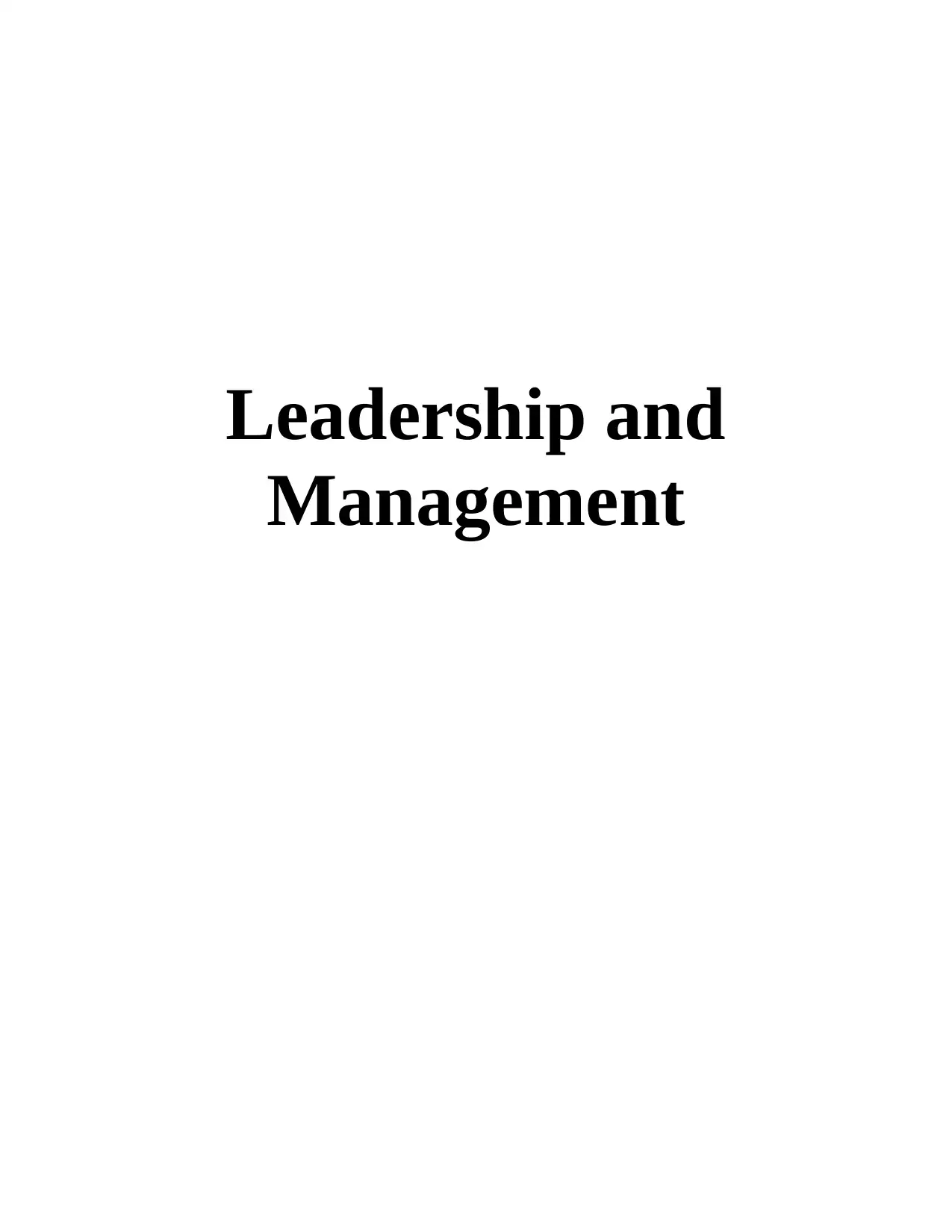
Leadership and
Management
Management
Paraphrase This Document
Need a fresh take? Get an instant paraphrase of this document with our AI Paraphraser
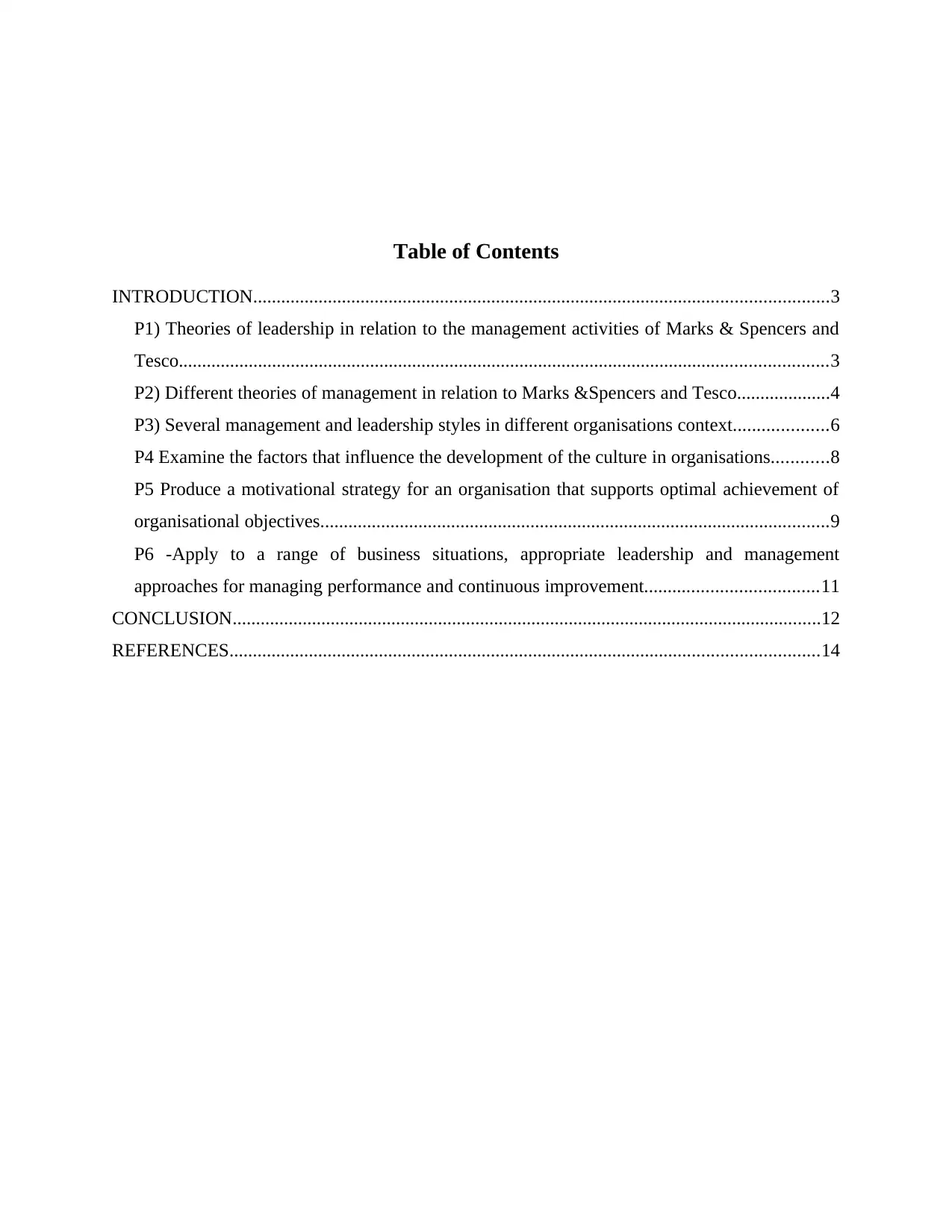
Table of Contents
INTRODUCTION...........................................................................................................................3
P1) Theories of leadership in relation to the management activities of Marks & Spencers and
Tesco...........................................................................................................................................3
P2) Different theories of management in relation to Marks &Spencers and Tesco....................4
P3) Several management and leadership styles in different organisations context....................6
P4 Examine the factors that influence the development of the culture in organisations............8
P5 Produce a motivational strategy for an organisation that supports optimal achievement of
organisational objectives.............................................................................................................9
P6 -Apply to a range of business situations, appropriate leadership and management
approaches for managing performance and continuous improvement.....................................11
CONCLUSION..............................................................................................................................12
REFERENCES..............................................................................................................................14
INTRODUCTION...........................................................................................................................3
P1) Theories of leadership in relation to the management activities of Marks & Spencers and
Tesco...........................................................................................................................................3
P2) Different theories of management in relation to Marks &Spencers and Tesco....................4
P3) Several management and leadership styles in different organisations context....................6
P4 Examine the factors that influence the development of the culture in organisations............8
P5 Produce a motivational strategy for an organisation that supports optimal achievement of
organisational objectives.............................................................................................................9
P6 -Apply to a range of business situations, appropriate leadership and management
approaches for managing performance and continuous improvement.....................................11
CONCLUSION..............................................................................................................................12
REFERENCES..............................................................................................................................14
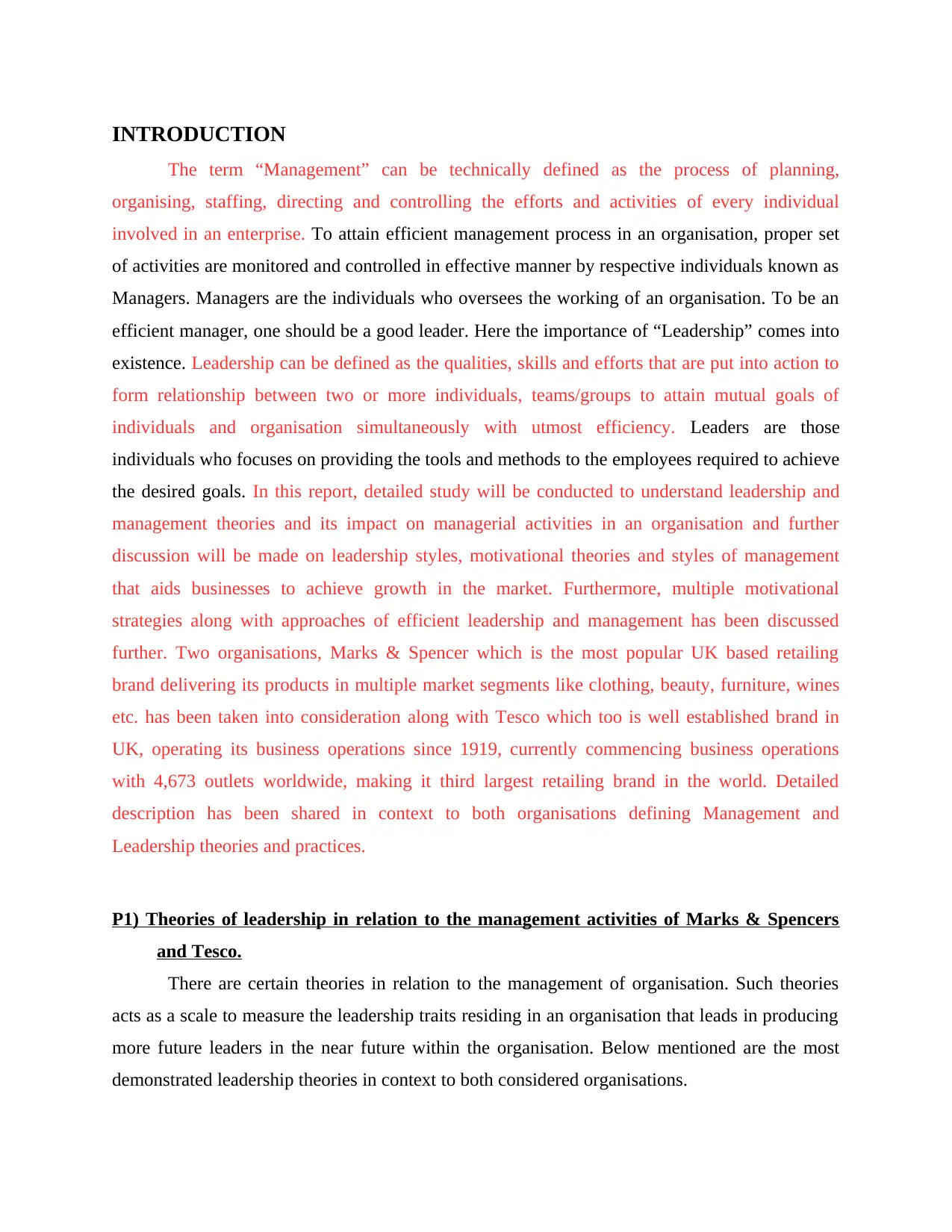
INTRODUCTION
The term “Management” can be technically defined as the process of planning,
organising, staffing, directing and controlling the efforts and activities of every individual
involved in an enterprise. To attain efficient management process in an organisation, proper set
of activities are monitored and controlled in effective manner by respective individuals known as
Managers. Managers are the individuals who oversees the working of an organisation. To be an
efficient manager, one should be a good leader. Here the importance of “Leadership” comes into
existence. Leadership can be defined as the qualities, skills and efforts that are put into action to
form relationship between two or more individuals, teams/groups to attain mutual goals of
individuals and organisation simultaneously with utmost efficiency. Leaders are those
individuals who focuses on providing the tools and methods to the employees required to achieve
the desired goals. In this report, detailed study will be conducted to understand leadership and
management theories and its impact on managerial activities in an organisation and further
discussion will be made on leadership styles, motivational theories and styles of management
that aids businesses to achieve growth in the market. Furthermore, multiple motivational
strategies along with approaches of efficient leadership and management has been discussed
further. Two organisations, Marks & Spencer which is the most popular UK based retailing
brand delivering its products in multiple market segments like clothing, beauty, furniture, wines
etc. has been taken into consideration along with Tesco which too is well established brand in
UK, operating its business operations since 1919, currently commencing business operations
with 4,673 outlets worldwide, making it third largest retailing brand in the world. Detailed
description has been shared in context to both organisations defining Management and
Leadership theories and practices.
P1) Theories of leadership in relation to the management activities of Marks & Spencers
and Tesco.
There are certain theories in relation to the management of organisation. Such theories
acts as a scale to measure the leadership traits residing in an organisation that leads in producing
more future leaders in the near future within the organisation. Below mentioned are the most
demonstrated leadership theories in context to both considered organisations.
The term “Management” can be technically defined as the process of planning,
organising, staffing, directing and controlling the efforts and activities of every individual
involved in an enterprise. To attain efficient management process in an organisation, proper set
of activities are monitored and controlled in effective manner by respective individuals known as
Managers. Managers are the individuals who oversees the working of an organisation. To be an
efficient manager, one should be a good leader. Here the importance of “Leadership” comes into
existence. Leadership can be defined as the qualities, skills and efforts that are put into action to
form relationship between two or more individuals, teams/groups to attain mutual goals of
individuals and organisation simultaneously with utmost efficiency. Leaders are those
individuals who focuses on providing the tools and methods to the employees required to achieve
the desired goals. In this report, detailed study will be conducted to understand leadership and
management theories and its impact on managerial activities in an organisation and further
discussion will be made on leadership styles, motivational theories and styles of management
that aids businesses to achieve growth in the market. Furthermore, multiple motivational
strategies along with approaches of efficient leadership and management has been discussed
further. Two organisations, Marks & Spencer which is the most popular UK based retailing
brand delivering its products in multiple market segments like clothing, beauty, furniture, wines
etc. has been taken into consideration along with Tesco which too is well established brand in
UK, operating its business operations since 1919, currently commencing business operations
with 4,673 outlets worldwide, making it third largest retailing brand in the world. Detailed
description has been shared in context to both organisations defining Management and
Leadership theories and practices.
P1) Theories of leadership in relation to the management activities of Marks & Spencers
and Tesco.
There are certain theories in relation to the management of organisation. Such theories
acts as a scale to measure the leadership traits residing in an organisation that leads in producing
more future leaders in the near future within the organisation. Below mentioned are the most
demonstrated leadership theories in context to both considered organisations.
⊘ This is a preview!⊘
Do you want full access?
Subscribe today to unlock all pages.

Trusted by 1+ million students worldwide
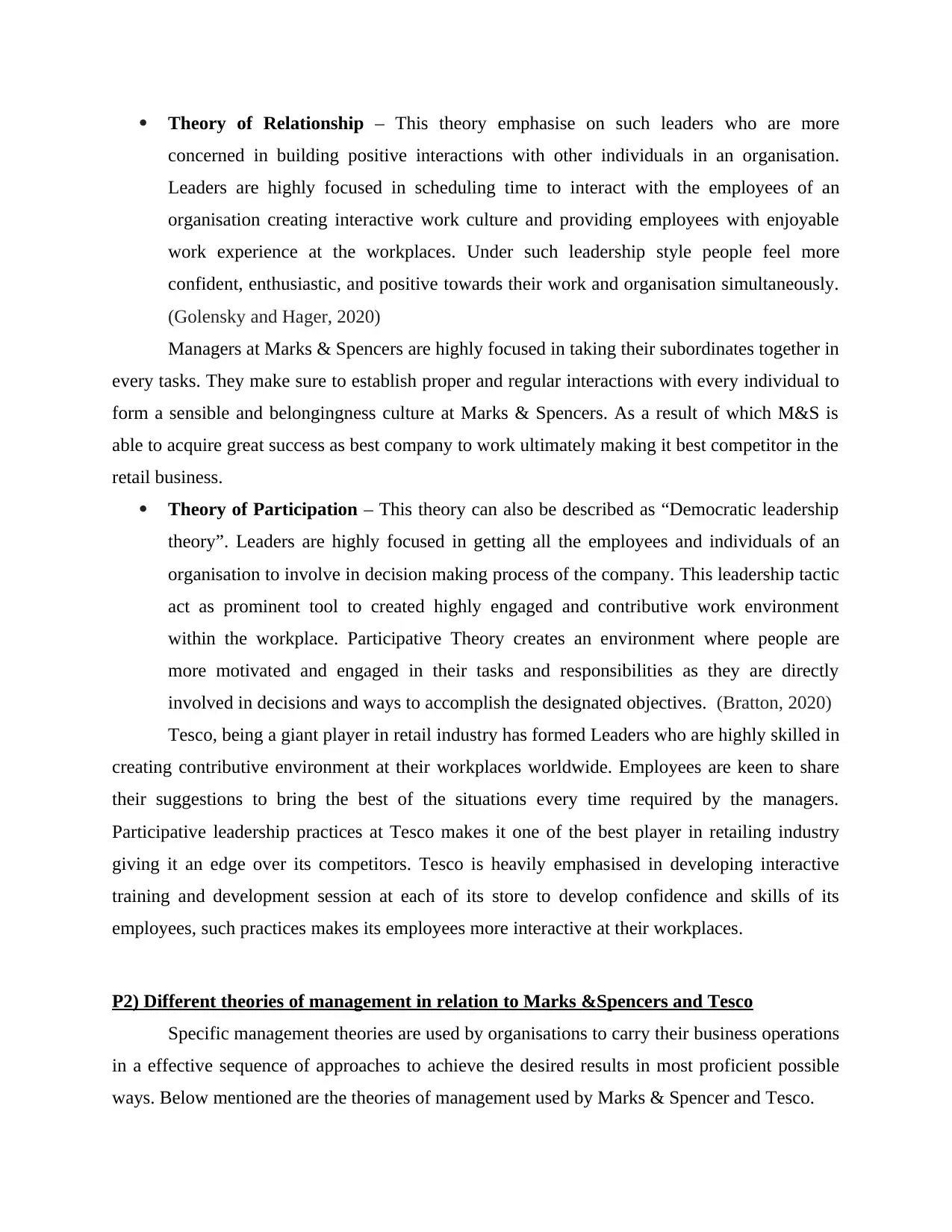
Theory of Relationship – This theory emphasise on such leaders who are more
concerned in building positive interactions with other individuals in an organisation.
Leaders are highly focused in scheduling time to interact with the employees of an
organisation creating interactive work culture and providing employees with enjoyable
work experience at the workplaces. Under such leadership style people feel more
confident, enthusiastic, and positive towards their work and organisation simultaneously.
(Golensky and Hager, 2020)
Managers at Marks & Spencers are highly focused in taking their subordinates together in
every tasks. They make sure to establish proper and regular interactions with every individual to
form a sensible and belongingness culture at Marks & Spencers. As a result of which M&S is
able to acquire great success as best company to work ultimately making it best competitor in the
retail business.
Theory of Participation – This theory can also be described as “Democratic leadership
theory”. Leaders are highly focused in getting all the employees and individuals of an
organisation to involve in decision making process of the company. This leadership tactic
act as prominent tool to created highly engaged and contributive work environment
within the workplace. Participative Theory creates an environment where people are
more motivated and engaged in their tasks and responsibilities as they are directly
involved in decisions and ways to accomplish the designated objectives. (Bratton, 2020)
Tesco, being a giant player in retail industry has formed Leaders who are highly skilled in
creating contributive environment at their workplaces worldwide. Employees are keen to share
their suggestions to bring the best of the situations every time required by the managers.
Participative leadership practices at Tesco makes it one of the best player in retailing industry
giving it an edge over its competitors. Tesco is heavily emphasised in developing interactive
training and development session at each of its store to develop confidence and skills of its
employees, such practices makes its employees more interactive at their workplaces.
P2) Different theories of management in relation to Marks &Spencers and Tesco
Specific management theories are used by organisations to carry their business operations
in a effective sequence of approaches to achieve the desired results in most proficient possible
ways. Below mentioned are the theories of management used by Marks & Spencer and Tesco.
concerned in building positive interactions with other individuals in an organisation.
Leaders are highly focused in scheduling time to interact with the employees of an
organisation creating interactive work culture and providing employees with enjoyable
work experience at the workplaces. Under such leadership style people feel more
confident, enthusiastic, and positive towards their work and organisation simultaneously.
(Golensky and Hager, 2020)
Managers at Marks & Spencers are highly focused in taking their subordinates together in
every tasks. They make sure to establish proper and regular interactions with every individual to
form a sensible and belongingness culture at Marks & Spencers. As a result of which M&S is
able to acquire great success as best company to work ultimately making it best competitor in the
retail business.
Theory of Participation – This theory can also be described as “Democratic leadership
theory”. Leaders are highly focused in getting all the employees and individuals of an
organisation to involve in decision making process of the company. This leadership tactic
act as prominent tool to created highly engaged and contributive work environment
within the workplace. Participative Theory creates an environment where people are
more motivated and engaged in their tasks and responsibilities as they are directly
involved in decisions and ways to accomplish the designated objectives. (Bratton, 2020)
Tesco, being a giant player in retail industry has formed Leaders who are highly skilled in
creating contributive environment at their workplaces worldwide. Employees are keen to share
their suggestions to bring the best of the situations every time required by the managers.
Participative leadership practices at Tesco makes it one of the best player in retailing industry
giving it an edge over its competitors. Tesco is heavily emphasised in developing interactive
training and development session at each of its store to develop confidence and skills of its
employees, such practices makes its employees more interactive at their workplaces.
P2) Different theories of management in relation to Marks &Spencers and Tesco
Specific management theories are used by organisations to carry their business operations
in a effective sequence of approaches to achieve the desired results in most proficient possible
ways. Below mentioned are the theories of management used by Marks & Spencer and Tesco.
Paraphrase This Document
Need a fresh take? Get an instant paraphrase of this document with our AI Paraphraser
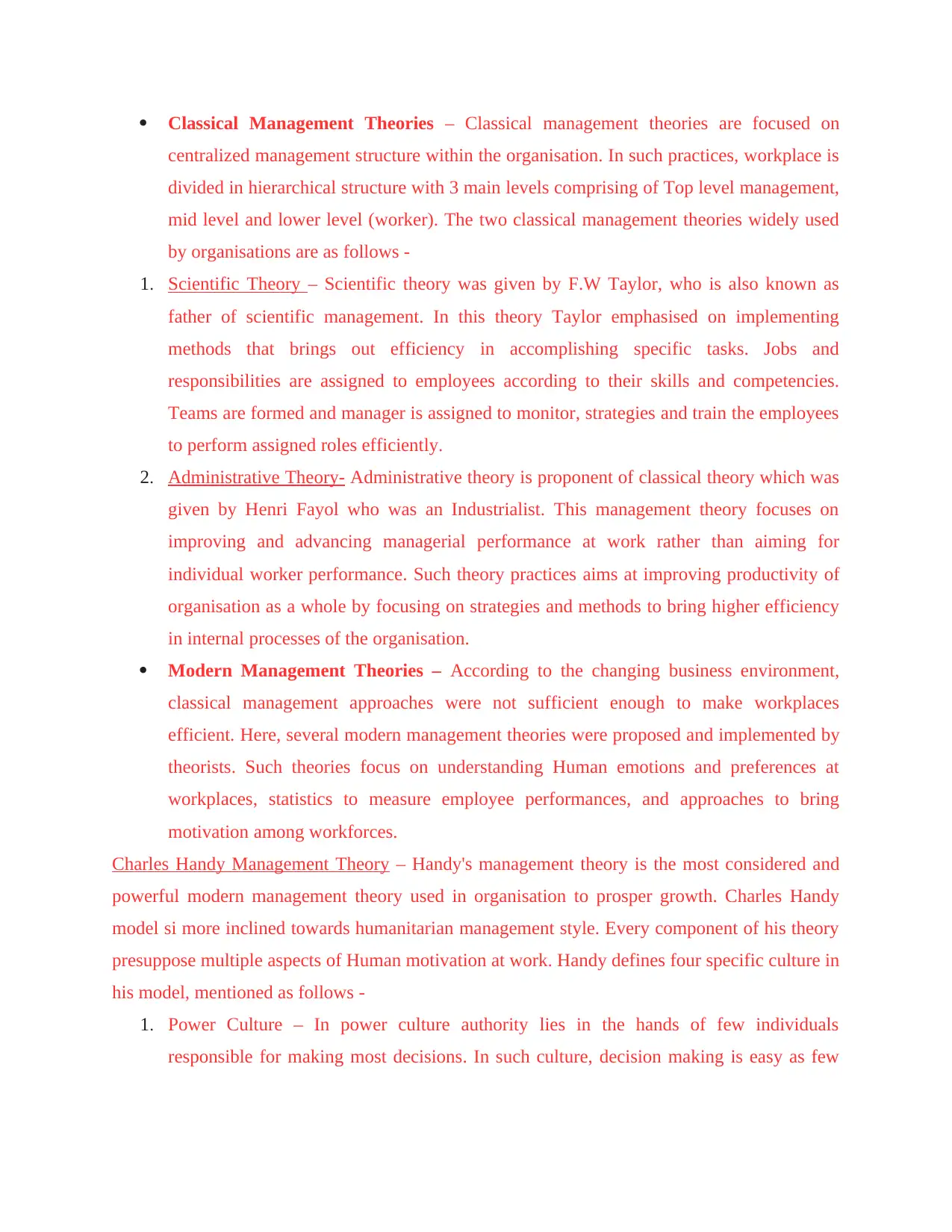
Classical Management Theories – Classical management theories are focused on
centralized management structure within the organisation. In such practices, workplace is
divided in hierarchical structure with 3 main levels comprising of Top level management,
mid level and lower level (worker). The two classical management theories widely used
by organisations are as follows -
1. Scientific Theory – Scientific theory was given by F.W Taylor, who is also known as
father of scientific management. In this theory Taylor emphasised on implementing
methods that brings out efficiency in accomplishing specific tasks. Jobs and
responsibilities are assigned to employees according to their skills and competencies.
Teams are formed and manager is assigned to monitor, strategies and train the employees
to perform assigned roles efficiently.
2. Administrative Theory- Administrative theory is proponent of classical theory which was
given by Henri Fayol who was an Industrialist. This management theory focuses on
improving and advancing managerial performance at work rather than aiming for
individual worker performance. Such theory practices aims at improving productivity of
organisation as a whole by focusing on strategies and methods to bring higher efficiency
in internal processes of the organisation.
Modern Management Theories – According to the changing business environment,
classical management approaches were not sufficient enough to make workplaces
efficient. Here, several modern management theories were proposed and implemented by
theorists. Such theories focus on understanding Human emotions and preferences at
workplaces, statistics to measure employee performances, and approaches to bring
motivation among workforces.
Charles Handy Management Theory – Handy's management theory is the most considered and
powerful modern management theory used in organisation to prosper growth. Charles Handy
model si more inclined towards humanitarian management style. Every component of his theory
presuppose multiple aspects of Human motivation at work. Handy defines four specific culture in
his model, mentioned as follows -
1. Power Culture – In power culture authority lies in the hands of few individuals
responsible for making most decisions. In such culture, decision making is easy as few
centralized management structure within the organisation. In such practices, workplace is
divided in hierarchical structure with 3 main levels comprising of Top level management,
mid level and lower level (worker). The two classical management theories widely used
by organisations are as follows -
1. Scientific Theory – Scientific theory was given by F.W Taylor, who is also known as
father of scientific management. In this theory Taylor emphasised on implementing
methods that brings out efficiency in accomplishing specific tasks. Jobs and
responsibilities are assigned to employees according to their skills and competencies.
Teams are formed and manager is assigned to monitor, strategies and train the employees
to perform assigned roles efficiently.
2. Administrative Theory- Administrative theory is proponent of classical theory which was
given by Henri Fayol who was an Industrialist. This management theory focuses on
improving and advancing managerial performance at work rather than aiming for
individual worker performance. Such theory practices aims at improving productivity of
organisation as a whole by focusing on strategies and methods to bring higher efficiency
in internal processes of the organisation.
Modern Management Theories – According to the changing business environment,
classical management approaches were not sufficient enough to make workplaces
efficient. Here, several modern management theories were proposed and implemented by
theorists. Such theories focus on understanding Human emotions and preferences at
workplaces, statistics to measure employee performances, and approaches to bring
motivation among workforces.
Charles Handy Management Theory – Handy's management theory is the most considered and
powerful modern management theory used in organisation to prosper growth. Charles Handy
model si more inclined towards humanitarian management style. Every component of his theory
presuppose multiple aspects of Human motivation at work. Handy defines four specific culture in
his model, mentioned as follows -
1. Power Culture – In power culture authority lies in the hands of few individuals
responsible for making most decisions. In such culture, decision making is easy as few
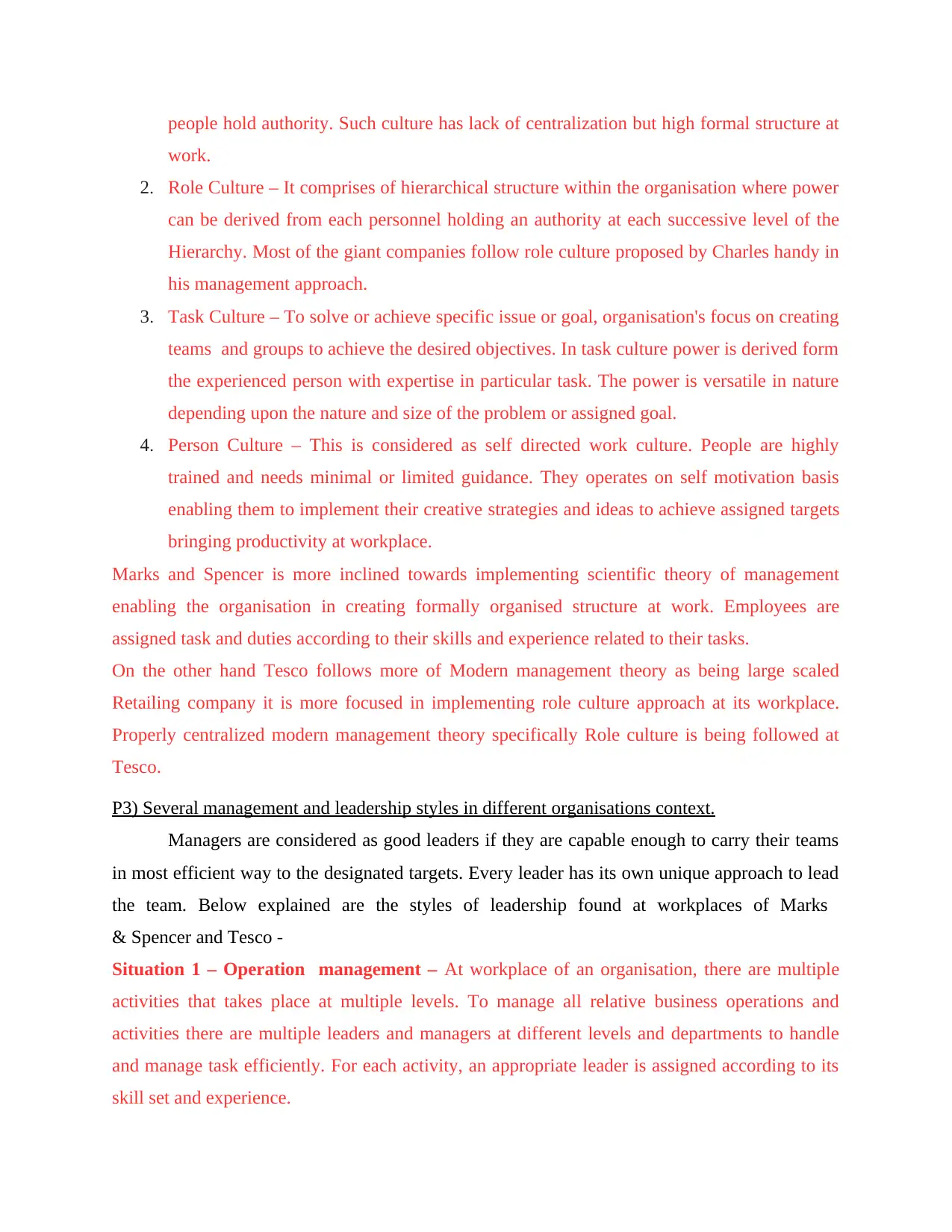
people hold authority. Such culture has lack of centralization but high formal structure at
work.
2. Role Culture – It comprises of hierarchical structure within the organisation where power
can be derived from each personnel holding an authority at each successive level of the
Hierarchy. Most of the giant companies follow role culture proposed by Charles handy in
his management approach.
3. Task Culture – To solve or achieve specific issue or goal, organisation's focus on creating
teams and groups to achieve the desired objectives. In task culture power is derived form
the experienced person with expertise in particular task. The power is versatile in nature
depending upon the nature and size of the problem or assigned goal.
4. Person Culture – This is considered as self directed work culture. People are highly
trained and needs minimal or limited guidance. They operates on self motivation basis
enabling them to implement their creative strategies and ideas to achieve assigned targets
bringing productivity at workplace.
Marks and Spencer is more inclined towards implementing scientific theory of management
enabling the organisation in creating formally organised structure at work. Employees are
assigned task and duties according to their skills and experience related to their tasks.
On the other hand Tesco follows more of Modern management theory as being large scaled
Retailing company it is more focused in implementing role culture approach at its workplace.
Properly centralized modern management theory specifically Role culture is being followed at
Tesco.
P3) Several management and leadership styles in different organisations context.
Managers are considered as good leaders if they are capable enough to carry their teams
in most efficient way to the designated targets. Every leader has its own unique approach to lead
the team. Below explained are the styles of leadership found at workplaces of Marks
& Spencer and Tesco -
Situation 1 – Operation management – At workplace of an organisation, there are multiple
activities that takes place at multiple levels. To manage all relative business operations and
activities there are multiple leaders and managers at different levels and departments to handle
and manage task efficiently. For each activity, an appropriate leader is assigned according to its
skill set and experience.
work.
2. Role Culture – It comprises of hierarchical structure within the organisation where power
can be derived from each personnel holding an authority at each successive level of the
Hierarchy. Most of the giant companies follow role culture proposed by Charles handy in
his management approach.
3. Task Culture – To solve or achieve specific issue or goal, organisation's focus on creating
teams and groups to achieve the desired objectives. In task culture power is derived form
the experienced person with expertise in particular task. The power is versatile in nature
depending upon the nature and size of the problem or assigned goal.
4. Person Culture – This is considered as self directed work culture. People are highly
trained and needs minimal or limited guidance. They operates on self motivation basis
enabling them to implement their creative strategies and ideas to achieve assigned targets
bringing productivity at workplace.
Marks and Spencer is more inclined towards implementing scientific theory of management
enabling the organisation in creating formally organised structure at work. Employees are
assigned task and duties according to their skills and experience related to their tasks.
On the other hand Tesco follows more of Modern management theory as being large scaled
Retailing company it is more focused in implementing role culture approach at its workplace.
Properly centralized modern management theory specifically Role culture is being followed at
Tesco.
P3) Several management and leadership styles in different organisations context.
Managers are considered as good leaders if they are capable enough to carry their teams
in most efficient way to the designated targets. Every leader has its own unique approach to lead
the team. Below explained are the styles of leadership found at workplaces of Marks
& Spencer and Tesco -
Situation 1 – Operation management – At workplace of an organisation, there are multiple
activities that takes place at multiple levels. To manage all relative business operations and
activities there are multiple leaders and managers at different levels and departments to handle
and manage task efficiently. For each activity, an appropriate leader is assigned according to its
skill set and experience.
⊘ This is a preview!⊘
Do you want full access?
Subscribe today to unlock all pages.

Trusted by 1+ million students worldwide
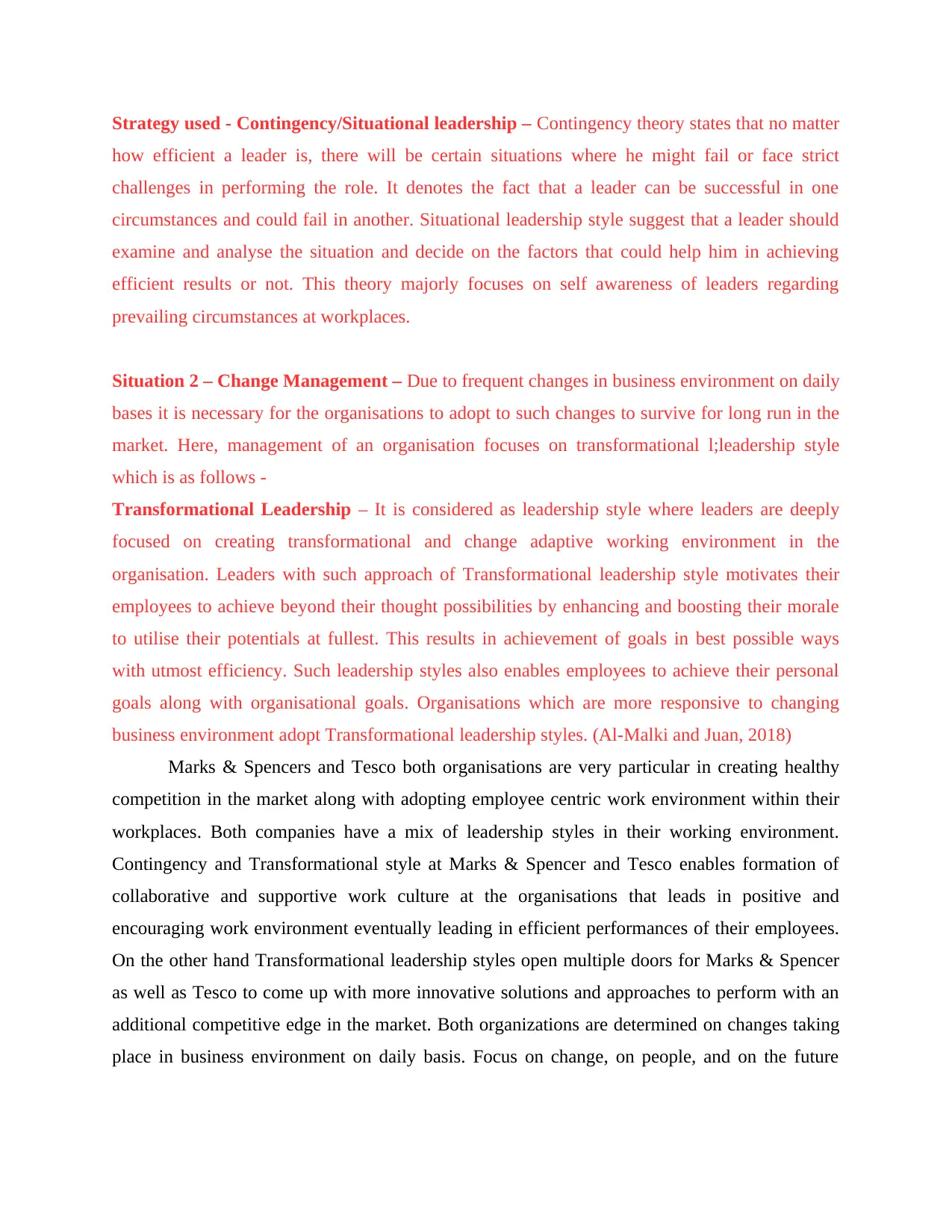
Strategy used - Contingency/Situational leadership – Contingency theory states that no matter
how efficient a leader is, there will be certain situations where he might fail or face strict
challenges in performing the role. It denotes the fact that a leader can be successful in one
circumstances and could fail in another. Situational leadership style suggest that a leader should
examine and analyse the situation and decide on the factors that could help him in achieving
efficient results or not. This theory majorly focuses on self awareness of leaders regarding
prevailing circumstances at workplaces.
Situation 2 – Change Management – Due to frequent changes in business environment on daily
bases it is necessary for the organisations to adopt to such changes to survive for long run in the
market. Here, management of an organisation focuses on transformational l;leadership style
which is as follows -
Transformational Leadership – It is considered as leadership style where leaders are deeply
focused on creating transformational and change adaptive working environment in the
organisation. Leaders with such approach of Transformational leadership style motivates their
employees to achieve beyond their thought possibilities by enhancing and boosting their morale
to utilise their potentials at fullest. This results in achievement of goals in best possible ways
with utmost efficiency. Such leadership styles also enables employees to achieve their personal
goals along with organisational goals. Organisations which are more responsive to changing
business environment adopt Transformational leadership styles. (Al-Malki and Juan, 2018)
Marks & Spencers and Tesco both organisations are very particular in creating healthy
competition in the market along with adopting employee centric work environment within their
workplaces. Both companies have a mix of leadership styles in their working environment.
Contingency and Transformational style at Marks & Spencer and Tesco enables formation of
collaborative and supportive work culture at the organisations that leads in positive and
encouraging work environment eventually leading in efficient performances of their employees.
On the other hand Transformational leadership styles open multiple doors for Marks & Spencer
as well as Tesco to come up with more innovative solutions and approaches to perform with an
additional competitive edge in the market. Both organizations are determined on changes taking
place in business environment on daily basis. Focus on change, on people, and on the future
how efficient a leader is, there will be certain situations where he might fail or face strict
challenges in performing the role. It denotes the fact that a leader can be successful in one
circumstances and could fail in another. Situational leadership style suggest that a leader should
examine and analyse the situation and decide on the factors that could help him in achieving
efficient results or not. This theory majorly focuses on self awareness of leaders regarding
prevailing circumstances at workplaces.
Situation 2 – Change Management – Due to frequent changes in business environment on daily
bases it is necessary for the organisations to adopt to such changes to survive for long run in the
market. Here, management of an organisation focuses on transformational l;leadership style
which is as follows -
Transformational Leadership – It is considered as leadership style where leaders are deeply
focused on creating transformational and change adaptive working environment in the
organisation. Leaders with such approach of Transformational leadership style motivates their
employees to achieve beyond their thought possibilities by enhancing and boosting their morale
to utilise their potentials at fullest. This results in achievement of goals in best possible ways
with utmost efficiency. Such leadership styles also enables employees to achieve their personal
goals along with organisational goals. Organisations which are more responsive to changing
business environment adopt Transformational leadership styles. (Al-Malki and Juan, 2018)
Marks & Spencers and Tesco both organisations are very particular in creating healthy
competition in the market along with adopting employee centric work environment within their
workplaces. Both companies have a mix of leadership styles in their working environment.
Contingency and Transformational style at Marks & Spencer and Tesco enables formation of
collaborative and supportive work culture at the organisations that leads in positive and
encouraging work environment eventually leading in efficient performances of their employees.
On the other hand Transformational leadership styles open multiple doors for Marks & Spencer
as well as Tesco to come up with more innovative solutions and approaches to perform with an
additional competitive edge in the market. Both organizations are determined on changes taking
place in business environment on daily basis. Focus on change, on people, and on the future
Paraphrase This Document
Need a fresh take? Get an instant paraphrase of this document with our AI Paraphraser
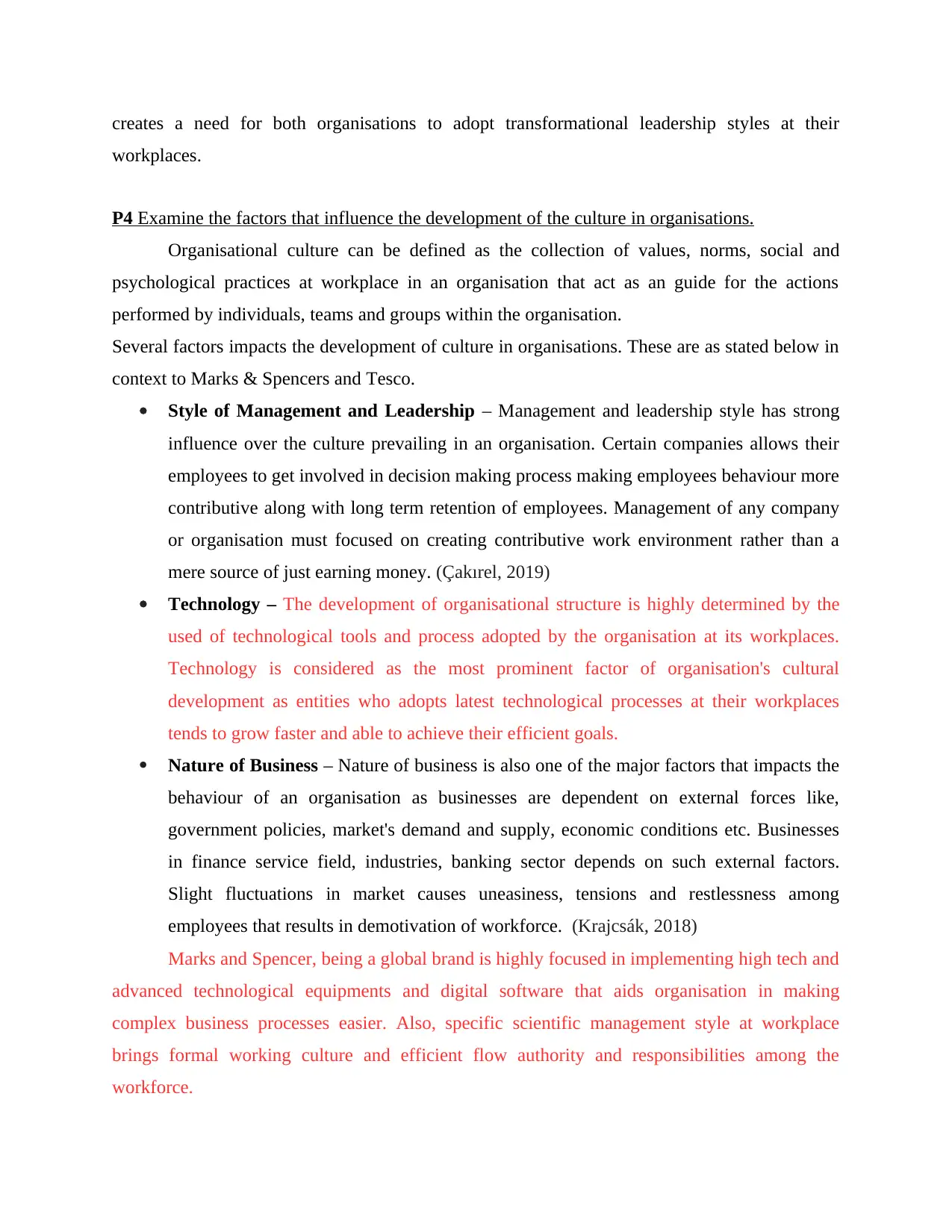
creates a need for both organisations to adopt transformational leadership styles at their
workplaces.
P4 Examine the factors that influence the development of the culture in organisations.
Organisational culture can be defined as the collection of values, norms, social and
psychological practices at workplace in an organisation that act as an guide for the actions
performed by individuals, teams and groups within the organisation.
Several factors impacts the development of culture in organisations. These are as stated below in
context to Marks & Spencers and Tesco.
Style of Management and Leadership – Management and leadership style has strong
influence over the culture prevailing in an organisation. Certain companies allows their
employees to get involved in decision making process making employees behaviour more
contributive along with long term retention of employees. Management of any company
or organisation must focused on creating contributive work environment rather than a
mere source of just earning money. (Çakırel, 2019)
Technology – The development of organisational structure is highly determined by the
used of technological tools and process adopted by the organisation at its workplaces.
Technology is considered as the most prominent factor of organisation's cultural
development as entities who adopts latest technological processes at their workplaces
tends to grow faster and able to achieve their efficient goals.
Nature of Business – Nature of business is also one of the major factors that impacts the
behaviour of an organisation as businesses are dependent on external forces like,
government policies, market's demand and supply, economic conditions etc. Businesses
in finance service field, industries, banking sector depends on such external factors.
Slight fluctuations in market causes uneasiness, tensions and restlessness among
employees that results in demotivation of workforce. (Krajcsák, 2018)
Marks and Spencer, being a global brand is highly focused in implementing high tech and
advanced technological equipments and digital software that aids organisation in making
complex business processes easier. Also, specific scientific management style at workplace
brings formal working culture and efficient flow authority and responsibilities among the
workforce.
workplaces.
P4 Examine the factors that influence the development of the culture in organisations.
Organisational culture can be defined as the collection of values, norms, social and
psychological practices at workplace in an organisation that act as an guide for the actions
performed by individuals, teams and groups within the organisation.
Several factors impacts the development of culture in organisations. These are as stated below in
context to Marks & Spencers and Tesco.
Style of Management and Leadership – Management and leadership style has strong
influence over the culture prevailing in an organisation. Certain companies allows their
employees to get involved in decision making process making employees behaviour more
contributive along with long term retention of employees. Management of any company
or organisation must focused on creating contributive work environment rather than a
mere source of just earning money. (Çakırel, 2019)
Technology – The development of organisational structure is highly determined by the
used of technological tools and process adopted by the organisation at its workplaces.
Technology is considered as the most prominent factor of organisation's cultural
development as entities who adopts latest technological processes at their workplaces
tends to grow faster and able to achieve their efficient goals.
Nature of Business – Nature of business is also one of the major factors that impacts the
behaviour of an organisation as businesses are dependent on external forces like,
government policies, market's demand and supply, economic conditions etc. Businesses
in finance service field, industries, banking sector depends on such external factors.
Slight fluctuations in market causes uneasiness, tensions and restlessness among
employees that results in demotivation of workforce. (Krajcsák, 2018)
Marks and Spencer, being a global brand is highly focused in implementing high tech and
advanced technological equipments and digital software that aids organisation in making
complex business processes easier. Also, specific scientific management style at workplace
brings formal working culture and efficient flow authority and responsibilities among the
workforce.
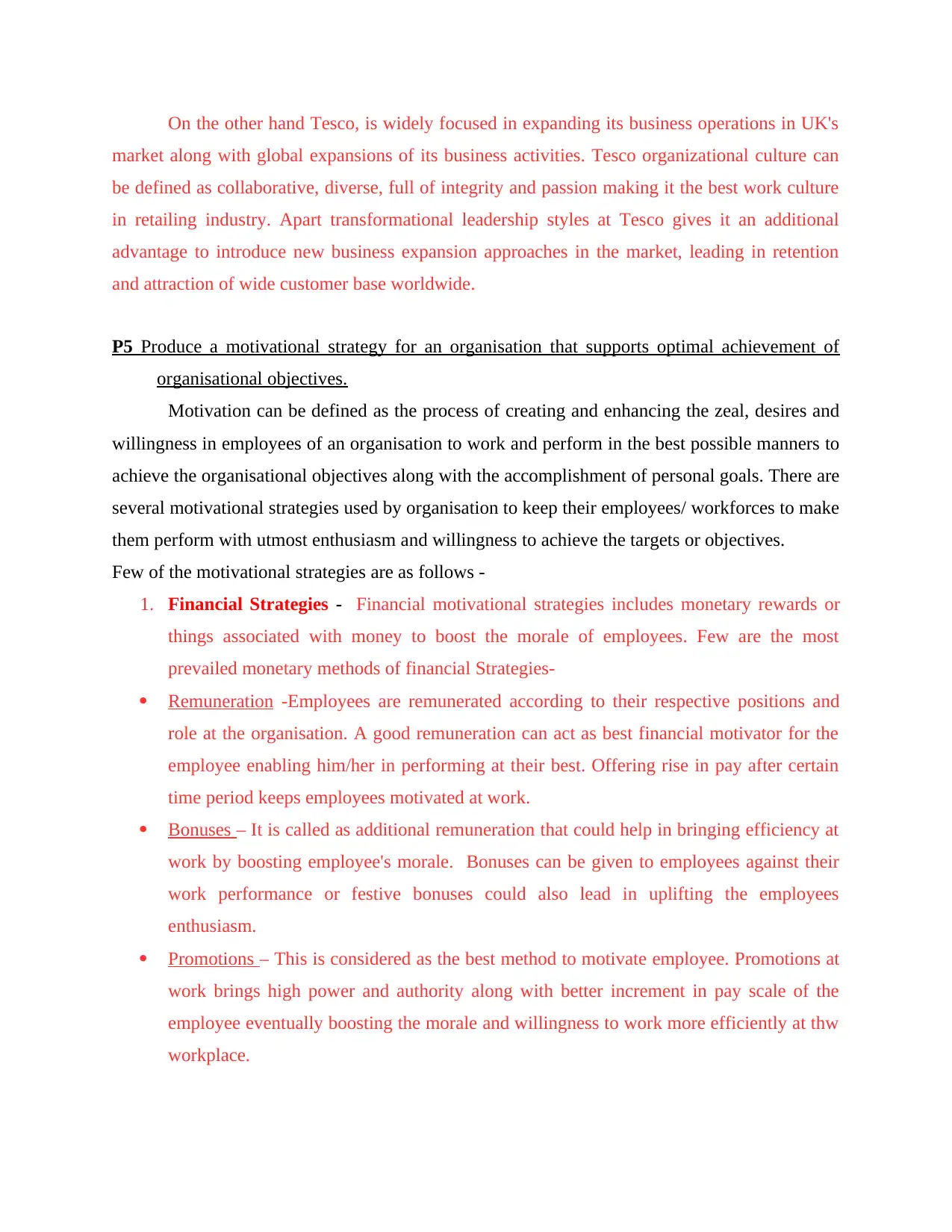
On the other hand Tesco, is widely focused in expanding its business operations in UK's
market along with global expansions of its business activities. Tesco organizational culture can
be defined as collaborative, diverse, full of integrity and passion making it the best work culture
in retailing industry. Apart transformational leadership styles at Tesco gives it an additional
advantage to introduce new business expansion approaches in the market, leading in retention
and attraction of wide customer base worldwide.
P5 Produce a motivational strategy for an organisation that supports optimal achievement of
organisational objectives.
Motivation can be defined as the process of creating and enhancing the zeal, desires and
willingness in employees of an organisation to work and perform in the best possible manners to
achieve the organisational objectives along with the accomplishment of personal goals. There are
several motivational strategies used by organisation to keep their employees/ workforces to make
them perform with utmost enthusiasm and willingness to achieve the targets or objectives.
Few of the motivational strategies are as follows -
1. Financial Strategies - Financial motivational strategies includes monetary rewards or
things associated with money to boost the morale of employees. Few are the most
prevailed monetary methods of financial Strategies-
Remuneration -Employees are remunerated according to their respective positions and
role at the organisation. A good remuneration can act as best financial motivator for the
employee enabling him/her in performing at their best. Offering rise in pay after certain
time period keeps employees motivated at work.
Bonuses – It is called as additional remuneration that could help in bringing efficiency at
work by boosting employee's morale. Bonuses can be given to employees against their
work performance or festive bonuses could also lead in uplifting the employees
enthusiasm.
Promotions – This is considered as the best method to motivate employee. Promotions at
work brings high power and authority along with better increment in pay scale of the
employee eventually boosting the morale and willingness to work more efficiently at thw
workplace.
market along with global expansions of its business activities. Tesco organizational culture can
be defined as collaborative, diverse, full of integrity and passion making it the best work culture
in retailing industry. Apart transformational leadership styles at Tesco gives it an additional
advantage to introduce new business expansion approaches in the market, leading in retention
and attraction of wide customer base worldwide.
P5 Produce a motivational strategy for an organisation that supports optimal achievement of
organisational objectives.
Motivation can be defined as the process of creating and enhancing the zeal, desires and
willingness in employees of an organisation to work and perform in the best possible manners to
achieve the organisational objectives along with the accomplishment of personal goals. There are
several motivational strategies used by organisation to keep their employees/ workforces to make
them perform with utmost enthusiasm and willingness to achieve the targets or objectives.
Few of the motivational strategies are as follows -
1. Financial Strategies - Financial motivational strategies includes monetary rewards or
things associated with money to boost the morale of employees. Few are the most
prevailed monetary methods of financial Strategies-
Remuneration -Employees are remunerated according to their respective positions and
role at the organisation. A good remuneration can act as best financial motivator for the
employee enabling him/her in performing at their best. Offering rise in pay after certain
time period keeps employees motivated at work.
Bonuses – It is called as additional remuneration that could help in bringing efficiency at
work by boosting employee's morale. Bonuses can be given to employees against their
work performance or festive bonuses could also lead in uplifting the employees
enthusiasm.
Promotions – This is considered as the best method to motivate employee. Promotions at
work brings high power and authority along with better increment in pay scale of the
employee eventually boosting the morale and willingness to work more efficiently at thw
workplace.
⊘ This is a preview!⊘
Do you want full access?
Subscribe today to unlock all pages.

Trusted by 1+ million students worldwide
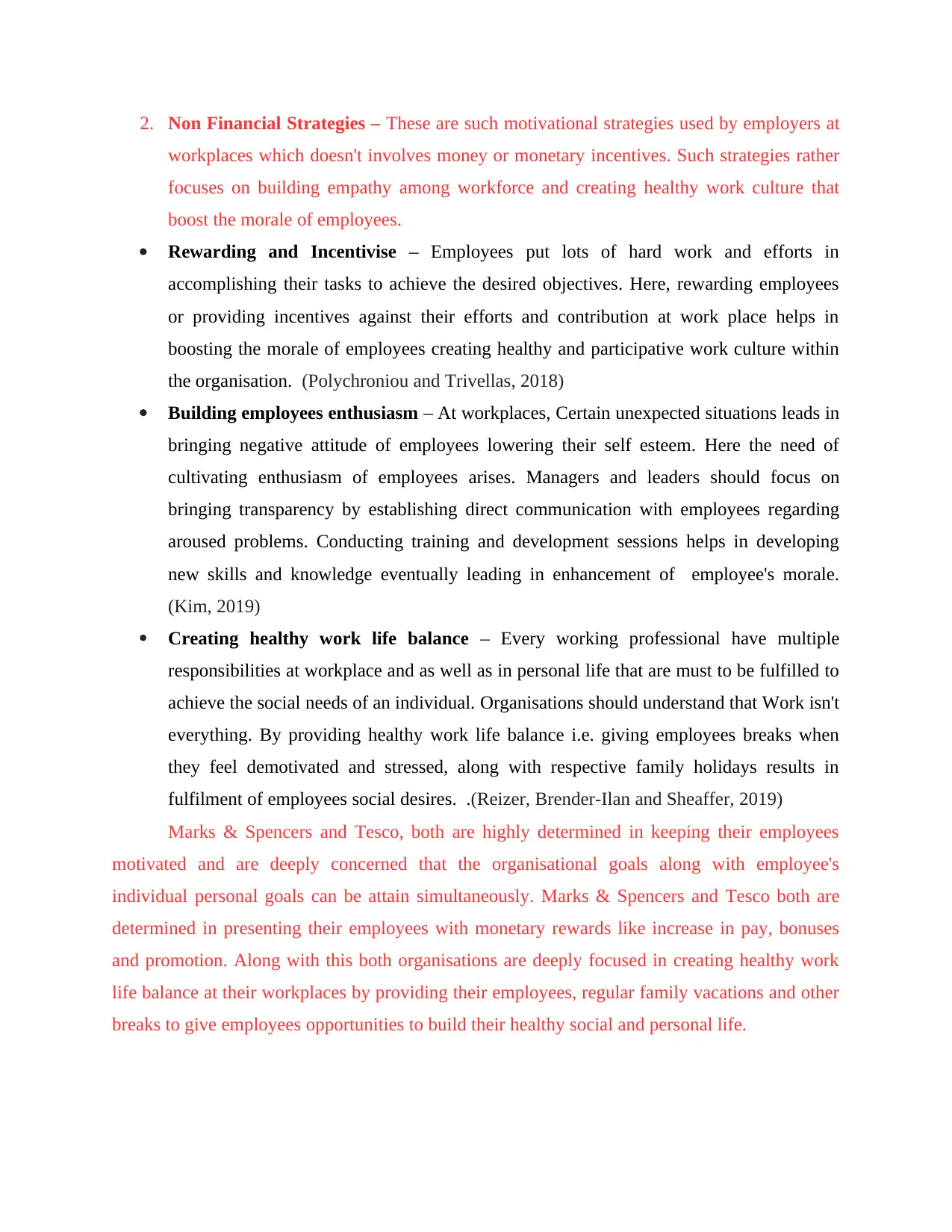
2. Non Financial Strategies – These are such motivational strategies used by employers at
workplaces which doesn't involves money or monetary incentives. Such strategies rather
focuses on building empathy among workforce and creating healthy work culture that
boost the morale of employees.
Rewarding and Incentivise – Employees put lots of hard work and efforts in
accomplishing their tasks to achieve the desired objectives. Here, rewarding employees
or providing incentives against their efforts and contribution at work place helps in
boosting the morale of employees creating healthy and participative work culture within
the organisation. (Polychroniou and Trivellas, 2018)
Building employees enthusiasm – At workplaces, Certain unexpected situations leads in
bringing negative attitude of employees lowering their self esteem. Here the need of
cultivating enthusiasm of employees arises. Managers and leaders should focus on
bringing transparency by establishing direct communication with employees regarding
aroused problems. Conducting training and development sessions helps in developing
new skills and knowledge eventually leading in enhancement of employee's morale.
(Kim, 2019)
Creating healthy work life balance – Every working professional have multiple
responsibilities at workplace and as well as in personal life that are must to be fulfilled to
achieve the social needs of an individual. Organisations should understand that Work isn't
everything. By providing healthy work life balance i.e. giving employees breaks when
they feel demotivated and stressed, along with respective family holidays results in
fulfilment of employees social desires. .(Reizer, Brender-Ilan and Sheaffer, 2019)
Marks & Spencers and Tesco, both are highly determined in keeping their employees
motivated and are deeply concerned that the organisational goals along with employee's
individual personal goals can be attain simultaneously. Marks & Spencers and Tesco both are
determined in presenting their employees with monetary rewards like increase in pay, bonuses
and promotion. Along with this both organisations are deeply focused in creating healthy work
life balance at their workplaces by providing their employees, regular family vacations and other
breaks to give employees opportunities to build their healthy social and personal life.
workplaces which doesn't involves money or monetary incentives. Such strategies rather
focuses on building empathy among workforce and creating healthy work culture that
boost the morale of employees.
Rewarding and Incentivise – Employees put lots of hard work and efforts in
accomplishing their tasks to achieve the desired objectives. Here, rewarding employees
or providing incentives against their efforts and contribution at work place helps in
boosting the morale of employees creating healthy and participative work culture within
the organisation. (Polychroniou and Trivellas, 2018)
Building employees enthusiasm – At workplaces, Certain unexpected situations leads in
bringing negative attitude of employees lowering their self esteem. Here the need of
cultivating enthusiasm of employees arises. Managers and leaders should focus on
bringing transparency by establishing direct communication with employees regarding
aroused problems. Conducting training and development sessions helps in developing
new skills and knowledge eventually leading in enhancement of employee's morale.
(Kim, 2019)
Creating healthy work life balance – Every working professional have multiple
responsibilities at workplace and as well as in personal life that are must to be fulfilled to
achieve the social needs of an individual. Organisations should understand that Work isn't
everything. By providing healthy work life balance i.e. giving employees breaks when
they feel demotivated and stressed, along with respective family holidays results in
fulfilment of employees social desires. .(Reizer, Brender-Ilan and Sheaffer, 2019)
Marks & Spencers and Tesco, both are highly determined in keeping their employees
motivated and are deeply concerned that the organisational goals along with employee's
individual personal goals can be attain simultaneously. Marks & Spencers and Tesco both are
determined in presenting their employees with monetary rewards like increase in pay, bonuses
and promotion. Along with this both organisations are deeply focused in creating healthy work
life balance at their workplaces by providing their employees, regular family vacations and other
breaks to give employees opportunities to build their healthy social and personal life.
Paraphrase This Document
Need a fresh take? Get an instant paraphrase of this document with our AI Paraphraser
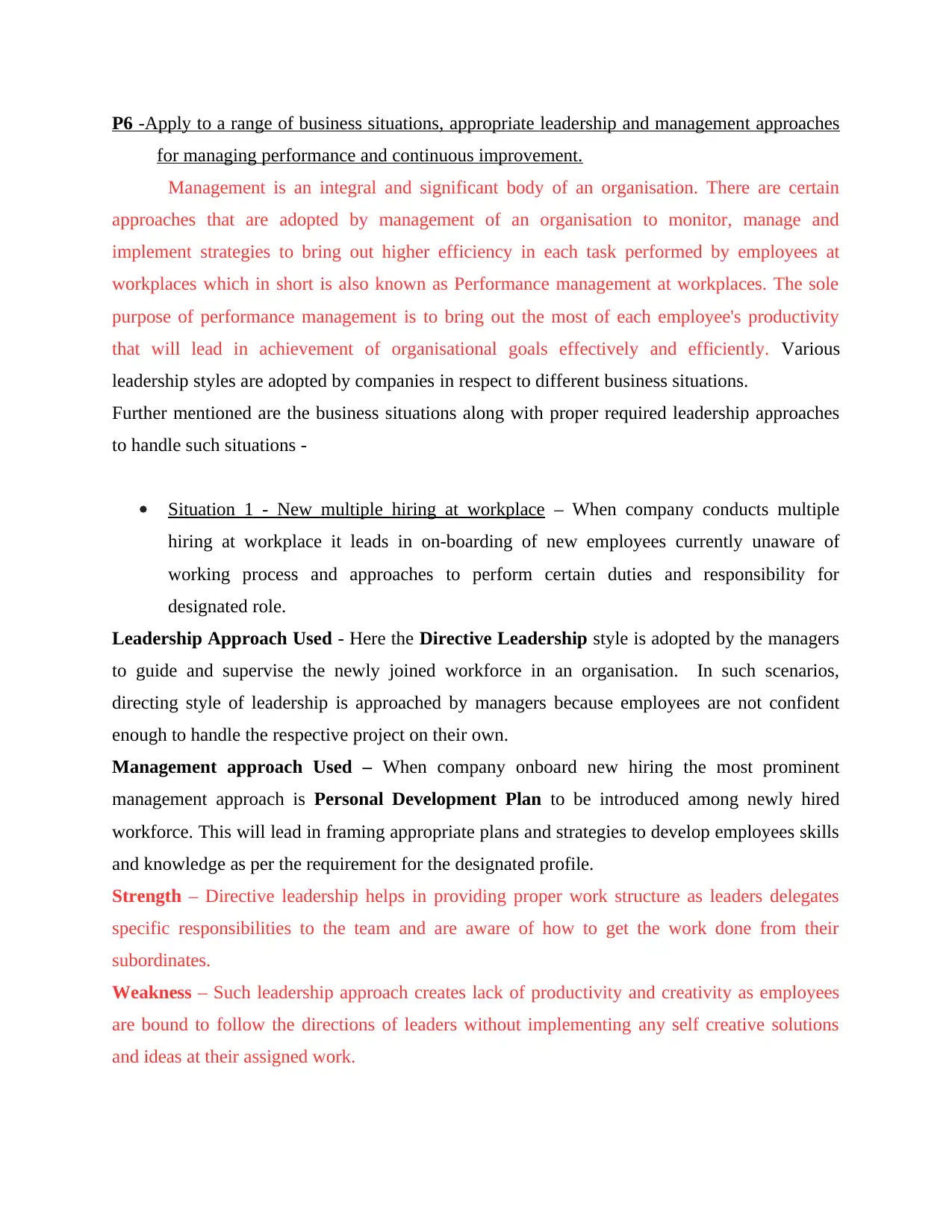
P6 -Apply to a range of business situations, appropriate leadership and management approaches
for managing performance and continuous improvement.
Management is an integral and significant body of an organisation. There are certain
approaches that are adopted by management of an organisation to monitor, manage and
implement strategies to bring out higher efficiency in each task performed by employees at
workplaces which in short is also known as Performance management at workplaces. The sole
purpose of performance management is to bring out the most of each employee's productivity
that will lead in achievement of organisational goals effectively and efficiently. Various
leadership styles are adopted by companies in respect to different business situations.
Further mentioned are the business situations along with proper required leadership approaches
to handle such situations -
Situation 1 - New multiple hiring at workplace – When company conducts multiple
hiring at workplace it leads in on-boarding of new employees currently unaware of
working process and approaches to perform certain duties and responsibility for
designated role.
Leadership Approach Used - Here the Directive Leadership style is adopted by the managers
to guide and supervise the newly joined workforce in an organisation. In such scenarios,
directing style of leadership is approached by managers because employees are not confident
enough to handle the respective project on their own.
Management approach Used – When company onboard new hiring the most prominent
management approach is Personal Development Plan to be introduced among newly hired
workforce. This will lead in framing appropriate plans and strategies to develop employees skills
and knowledge as per the requirement for the designated profile.
Strength – Directive leadership helps in providing proper work structure as leaders delegates
specific responsibilities to the team and are aware of how to get the work done from their
subordinates.
Weakness – Such leadership approach creates lack of productivity and creativity as employees
are bound to follow the directions of leaders without implementing any self creative solutions
and ideas at their assigned work.
for managing performance and continuous improvement.
Management is an integral and significant body of an organisation. There are certain
approaches that are adopted by management of an organisation to monitor, manage and
implement strategies to bring out higher efficiency in each task performed by employees at
workplaces which in short is also known as Performance management at workplaces. The sole
purpose of performance management is to bring out the most of each employee's productivity
that will lead in achievement of organisational goals effectively and efficiently. Various
leadership styles are adopted by companies in respect to different business situations.
Further mentioned are the business situations along with proper required leadership approaches
to handle such situations -
Situation 1 - New multiple hiring at workplace – When company conducts multiple
hiring at workplace it leads in on-boarding of new employees currently unaware of
working process and approaches to perform certain duties and responsibility for
designated role.
Leadership Approach Used - Here the Directive Leadership style is adopted by the managers
to guide and supervise the newly joined workforce in an organisation. In such scenarios,
directing style of leadership is approached by managers because employees are not confident
enough to handle the respective project on their own.
Management approach Used – When company onboard new hiring the most prominent
management approach is Personal Development Plan to be introduced among newly hired
workforce. This will lead in framing appropriate plans and strategies to develop employees skills
and knowledge as per the requirement for the designated profile.
Strength – Directive leadership helps in providing proper work structure as leaders delegates
specific responsibilities to the team and are aware of how to get the work done from their
subordinates.
Weakness – Such leadership approach creates lack of productivity and creativity as employees
are bound to follow the directions of leaders without implementing any self creative solutions
and ideas at their assigned work.
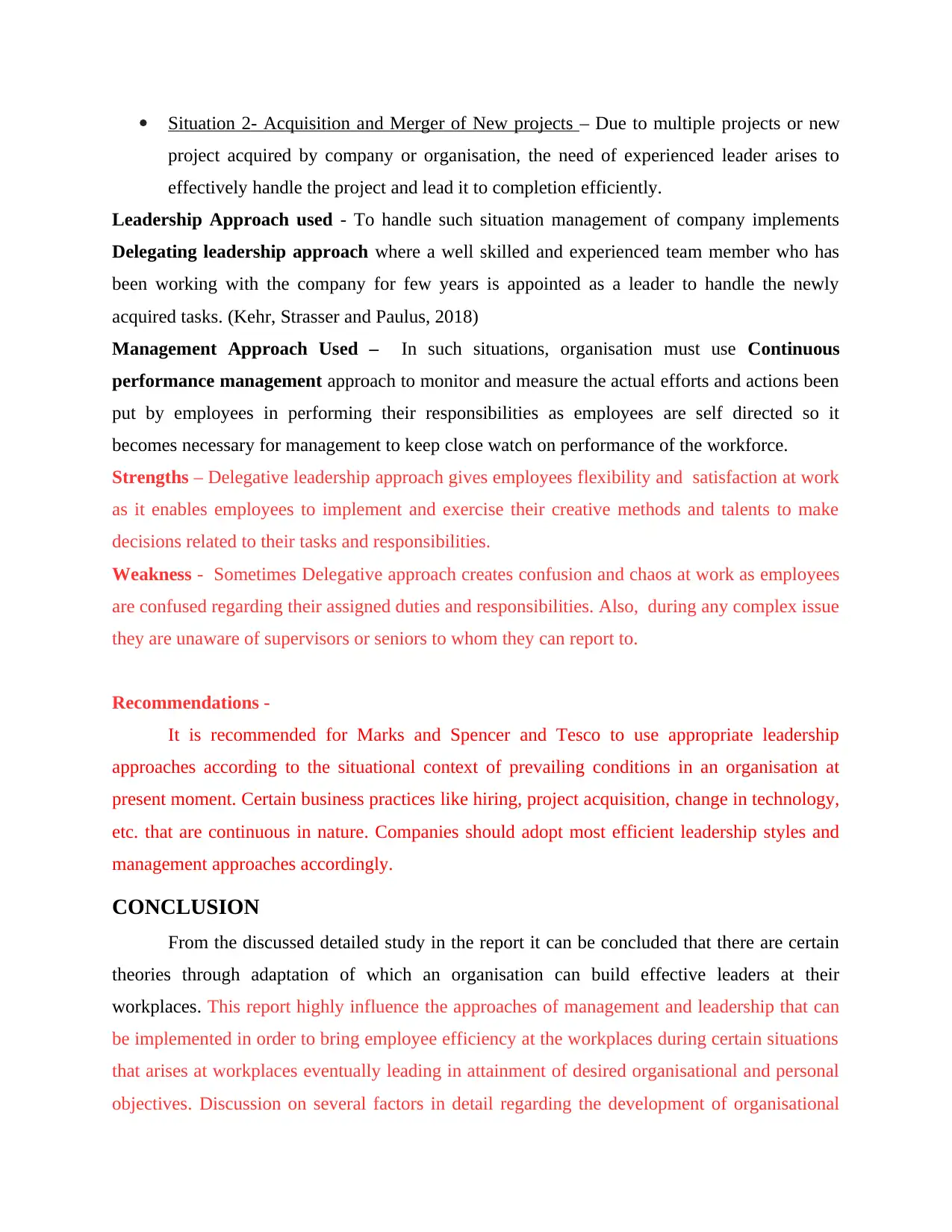
Situation 2- Acquisition and Merger of New projects – Due to multiple projects or new
project acquired by company or organisation, the need of experienced leader arises to
effectively handle the project and lead it to completion efficiently.
Leadership Approach used - To handle such situation management of company implements
Delegating leadership approach where a well skilled and experienced team member who has
been working with the company for few years is appointed as a leader to handle the newly
acquired tasks. (Kehr, Strasser and Paulus, 2018)
Management Approach Used – In such situations, organisation must use Continuous
performance management approach to monitor and measure the actual efforts and actions been
put by employees in performing their responsibilities as employees are self directed so it
becomes necessary for management to keep close watch on performance of the workforce.
Strengths – Delegative leadership approach gives employees flexibility and satisfaction at work
as it enables employees to implement and exercise their creative methods and talents to make
decisions related to their tasks and responsibilities.
Weakness - Sometimes Delegative approach creates confusion and chaos at work as employees
are confused regarding their assigned duties and responsibilities. Also, during any complex issue
they are unaware of supervisors or seniors to whom they can report to.
Recommendations -
It is recommended for Marks and Spencer and Tesco to use appropriate leadership
approaches according to the situational context of prevailing conditions in an organisation at
present moment. Certain business practices like hiring, project acquisition, change in technology,
etc. that are continuous in nature. Companies should adopt most efficient leadership styles and
management approaches accordingly.
CONCLUSION
From the discussed detailed study in the report it can be concluded that there are certain
theories through adaptation of which an organisation can build effective leaders at their
workplaces. This report highly influence the approaches of management and leadership that can
be implemented in order to bring employee efficiency at the workplaces during certain situations
that arises at workplaces eventually leading in attainment of desired organisational and personal
objectives. Discussion on several factors in detail regarding the development of organisational
project acquired by company or organisation, the need of experienced leader arises to
effectively handle the project and lead it to completion efficiently.
Leadership Approach used - To handle such situation management of company implements
Delegating leadership approach where a well skilled and experienced team member who has
been working with the company for few years is appointed as a leader to handle the newly
acquired tasks. (Kehr, Strasser and Paulus, 2018)
Management Approach Used – In such situations, organisation must use Continuous
performance management approach to monitor and measure the actual efforts and actions been
put by employees in performing their responsibilities as employees are self directed so it
becomes necessary for management to keep close watch on performance of the workforce.
Strengths – Delegative leadership approach gives employees flexibility and satisfaction at work
as it enables employees to implement and exercise their creative methods and talents to make
decisions related to their tasks and responsibilities.
Weakness - Sometimes Delegative approach creates confusion and chaos at work as employees
are confused regarding their assigned duties and responsibilities. Also, during any complex issue
they are unaware of supervisors or seniors to whom they can report to.
Recommendations -
It is recommended for Marks and Spencer and Tesco to use appropriate leadership
approaches according to the situational context of prevailing conditions in an organisation at
present moment. Certain business practices like hiring, project acquisition, change in technology,
etc. that are continuous in nature. Companies should adopt most efficient leadership styles and
management approaches accordingly.
CONCLUSION
From the discussed detailed study in the report it can be concluded that there are certain
theories through adaptation of which an organisation can build effective leaders at their
workplaces. This report highly influence the approaches of management and leadership that can
be implemented in order to bring employee efficiency at the workplaces during certain situations
that arises at workplaces eventually leading in attainment of desired organisational and personal
objectives. Discussion on several factors in detail regarding the development of organisational
⊘ This is a preview!⊘
Do you want full access?
Subscribe today to unlock all pages.

Trusted by 1+ million students worldwide
1 out of 16
Related Documents
Your All-in-One AI-Powered Toolkit for Academic Success.
+13062052269
info@desklib.com
Available 24*7 on WhatsApp / Email
![[object Object]](/_next/static/media/star-bottom.7253800d.svg)
Unlock your academic potential
Copyright © 2020–2025 A2Z Services. All Rights Reserved. Developed and managed by ZUCOL.





